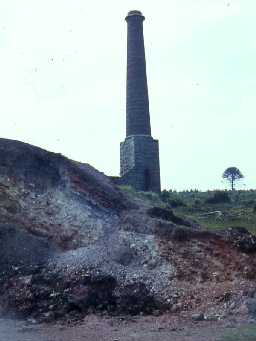Ford Colliery (Ford)
Ford Colliery was worked for coal from at least mid-17th century. It was first mentioned in documentary sources when the property passed from the Carr family. A 19th century account of the workings of the colliery relates that originally the old pit tapped the Scremerston seam, a stony coal, but later the same shaft was sunk to the main coal. A report later in the 19th century, when the marquis of Waterford came into the property records, '...the works were carried on after the fashion of pillar work. At this time there was a pit called Ben Oxley's Pitt...There was a water wheel...supplied by Ford Moss...The pillar work is now a drowned waste, but there is a barrier between the pillar work and the drowned waste of about 107 yards thick.' The coal lay in four seams and was wrought at Ford and Etal. The colliery engine house chimney is a Grade II Listed Building protected by law. It is built of stone and brick with a square stone base and a round brick chimney. Other colliery buildings have been demolished, but the foundations can still be seen of the miner's cottages and other buildings. (1-10)
NT 96633778. The standing and buried remains of Ford Colliery on Ford Moss. The colliery was worked from at least the mid 17th century through to 1914 and the visible remains represent multi-phase mining activity stretching over nearly 3 centuries. The earliest recorded working consisted of outcrop and bell-pit mining. The first deeper workings date from 1697, with the construction of a water level drift and winding shafts. Drainage proved to be a constant problem and additions and improvements to the drainage system continued throughout the 18th century. These included the provision of a windmill in 1762-63 and an underground water wheel in 1767-68. The colliery was expanded in 1844, with the sinking of a new pit, and by 1883 the site included miners' cottages, an engine house, blacksmith's shop and stables.
The surviving remains include a series of large pits, now infilled, but visible as earthworks. The remains of a possible beam engine pumping house lie at the southern end of the site, along with a boiler house and chimney (Listed Grade II). Further engine houses, workers' housing, stables and sheds have also been identified. Scheduled. (5)
The surviving remains include a series of large pits, now infilled, but visible as earthworks. The remains of a possible beam engine pumping house lie at the southern end of the site, along with a boiler house and chimney (Listed Grade II). Further engine houses, workers' housing, stables and sheds have also been identified. Scheduled. (11a)
NT 96633778. The standing and buried remains of Ford Colliery on Ford Moss. The colliery was worked from at least the mid 17th century through to 1914 and the visible remains represent multi-phase mining activity stretching over nearly 3 centuries. The earliest recorded working consisted of outcrop and bell-pit mining. The first deeper workings date from 1697, with the construction of a water level drift and winding shafts. Drainage proved to be a constant problem and additions and improvements to the drainage system continued throughout the 18th century. These included the provision of a windmill in 1762-63 and an underground water wheel in 1767-68. The colliery was expanded in 1844, with the sinking of a new pit, and by 1883 the site included miners' cottages, an engine house, blacksmith's shop and stables.
The surviving remains include a series of large pits, now infilled, but visible as earthworks. The remains of a possible beam engine pumping house lie at the southern end of the site, along with a boiler house and chimney (Listed Grade II). Further engine houses, workers' housing, stables and sheds have also been identified. Scheduled. (5)
The surviving remains include a series of large pits, now infilled, but visible as earthworks. The remains of a possible beam engine pumping house lie at the southern end of the site, along with a boiler house and chimney (Listed Grade II). Further engine houses, workers' housing, stables and sheds have also been identified. Scheduled. (11a)
N1975
Post Medieval (1540 to 1901)
20th Century (1901 to 2000)
20th Century (1901 to 2000)
DESK BASED ASSESSMENT, Ford Moss Colliery, Ford Village 2010; Pre-Construct Archaeology
MEASURED SURVEY, Ford Moss Colliery, Ford Village 2010; Pre-Construct Archaeology
BUILDING SURVEY, Ford Colliery Engine Houses 2012; Addyman Archaeology
MEASURED SURVEY, Ford Moss Colliery, Ford Village 2010; Pre-Construct Archaeology
BUILDING SURVEY, Ford Colliery Engine Houses 2012; Addyman Archaeology
Disclaimer -
Please note that this information has been compiled from a number of different sources. Durham County Council and Northumberland County Council can accept no responsibility for any inaccuracy contained therein. If you wish to use/copy any of the images, please ensure that you read the Copyright information provided.
